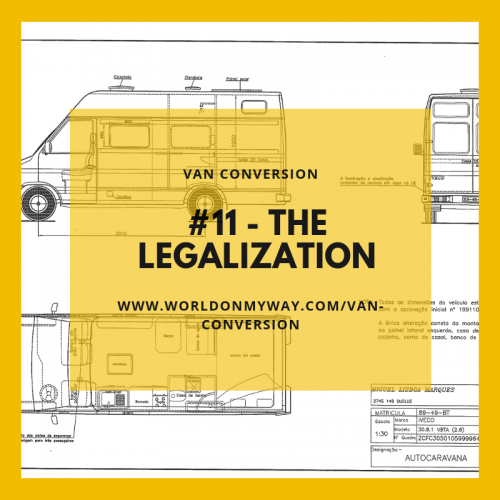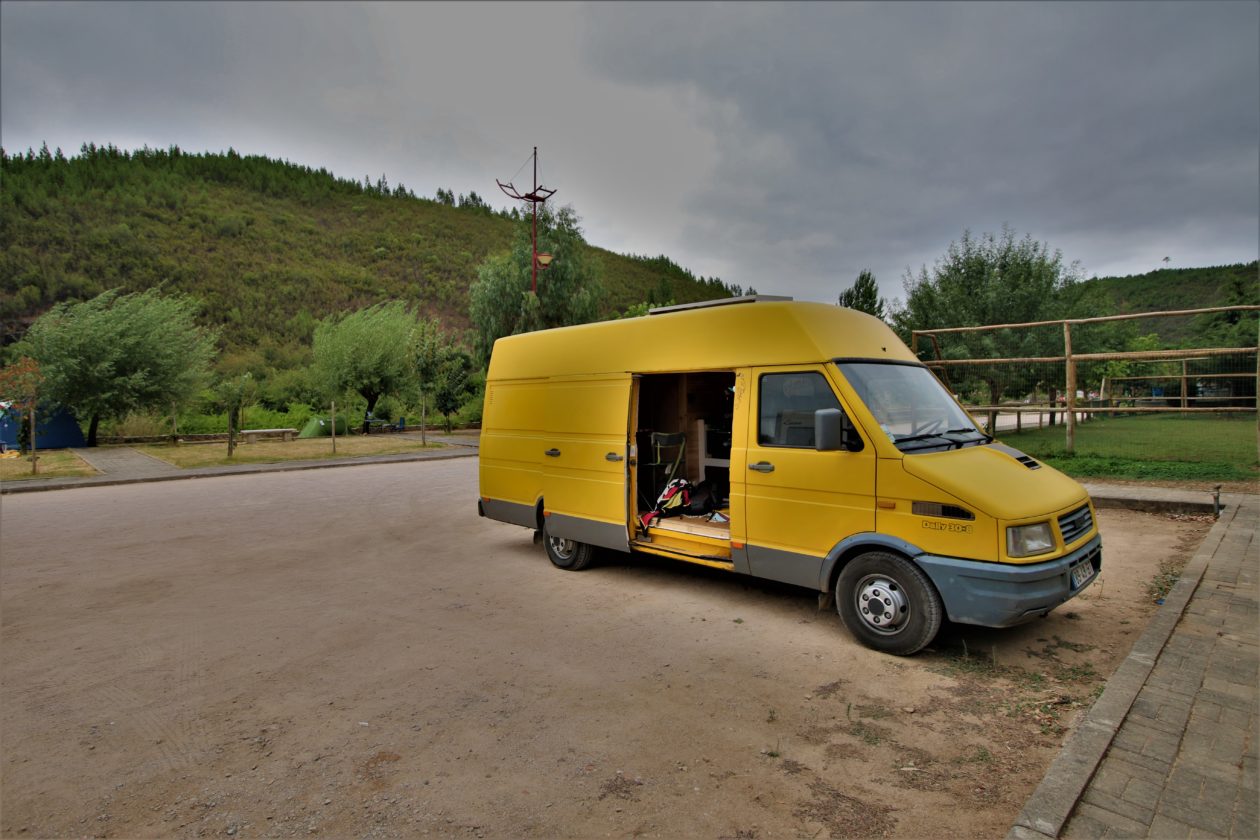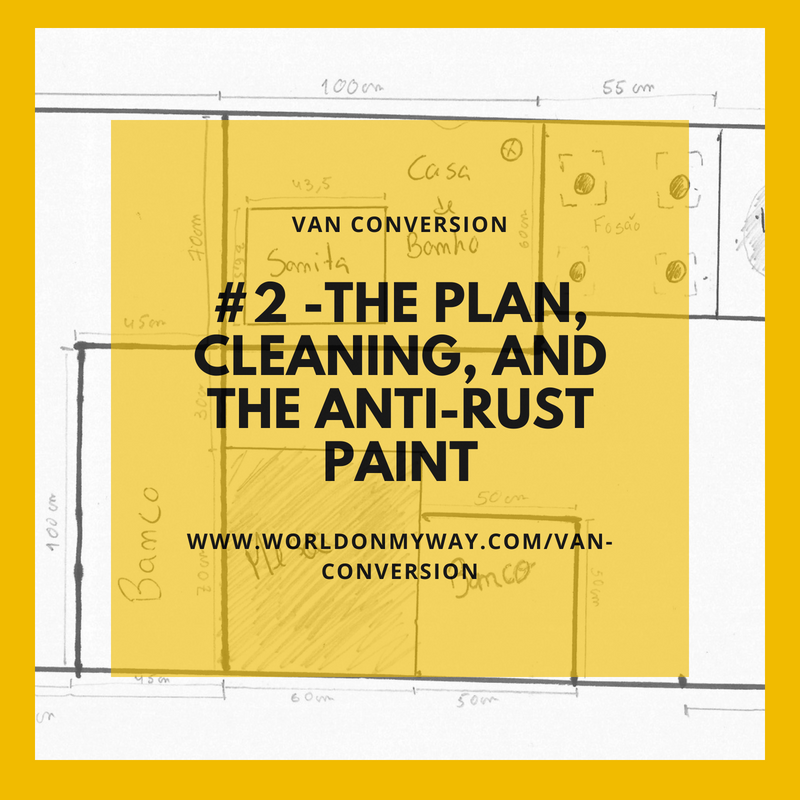
First of all, we converted the van into Portugal, and this article talks about the process of legalization in our country.
Legalization was undoubtedly the worst part of this transformation. We say this not because it took too long, or because it was a big bureaucracy, but because we felt stolen by having to pay € 1300 + € 450 of taxes and inherent costs. Just to be able to sleep and cook inside a vehicle, which happens to be ours and that pays circulation tax. We paid almost as much for the legalization as for the van.
In our opinion it is an extremely high value, for no reason since it does not make sense for a car with 25 years to pay 1300 euros of tax to change category. What is worse is that it is one of the main reasons people fail to embark on such a project.
Apart from value, there are many rules in Portugal (in the future more and more) that often make it impossible to legalize certain types of vehicles in motorhomes. People should be free to do what they want within their own vehicle, as long as it does not compromise their own and the safety of others.
Just look at the Germans who turn everything from ambulances to fire engines and end up doing very funny things without the barriers of legalization.
In our case we turn to the service of a professional in the area who handled everything and we sincerely think that this is the best option, either because if you have a friend engineer who makes a plan of the free van, or we will always have to pay for this service .. In this way, we ended up not having to do anything, just pay and sign papers.
We paid 450 €, which includes IMT fee (150 €) + van design – all the hassles we were going to have to do this ourselves. However we have always been aware of everything and we will explain here the various stages of the process.
It is important to note that we did not have to do any inspections and that from the moment we spoke with the person in charge of the legalization until we received the updated DUA at home, it took four months.
What is the legalization?
The legalization is the change of the category of a merchandise vehicle for the motorhome and the payment with the IMTT of the costs of the process and to the tax and customs entity of the corresponding ISV (+ VAT) of the change of category.
It is possible to change the type of vehicle for autovienda and for special dormitory.
Basically in the case of the ” special dormitory ” you can have a bed, a closet, maybe a small window, but you can not do plumbing, gas, or bathroom. In the case of motorhome one can do all this.
However there are people who make a special dormitory because it is much cheaper and they have a bathroom and all this … the probability of having problems with the police turns out to be tiny in this way, but it is enough once to have problems, since in the strictness of the law, it is illegal.
Do or not do the legalization?
Many people approach us with questions related to legalization and whether or not they should legalize and the answer is not easy.
From the moment you change the structure of the van (fix furniture), put things outdoors (skylights, solar panel), make holes in the box (windows) in the strictness of the law, requires a legalization.
The issue is that from what we see and tell us the fines or seizure of documents / vehicle are very rare in Portugal and the police many times during the approach are not concernabout this, but everything depends on the situation, the police, the transformation …
The more elaborate the transformation, the more necessary is a legalization. But in the end it all depends on the risks that a person is willing to take.
We decided to legalize because we wanted to make a complete transformation, with gas, windows, bathroom … And basically, this gives too much work and costs too much money so that we can have the chance to have the van seized, or pay a fine that almost is the value of legalization.

The most important factor that made us legalize the van is that we are going to use it probably about 200 days a year, so the risk simply did not pay off. The fine can go up to € 1250 and entails seizure of documents or the vehicle.
However if we had made a smaller van, without bathroom and with less windows, we had not legalized.
Lastly, a legalized van is worth more than an unlicensed van, so we decided to legalize it.
Those who do not legalize and want to avoid problems should place the furniture strapped or fitted so that they are not bolted to the structure and avoid making windows. At the time of inspection they should see if there is no problem or if they should take it all out.

The process of legalization
First of all, we will try to be as explicit / correct as possible, but in Portugal standards are always changing and changes in vehicle transformation are expected at the end of this year (2018), so we do not know if things will keep it this way.
What we can say is that at least 3 people working in the area warned us of these changes and recommended that we handle legalization as quickly as possible, as they will increase the requirements when changing the category of vehicle and can become difficult for a particular power to legalize the transformation of a vehicle.
As is common in Portugal, it is not easy to get to talk with the State entity that deals with these things, nor to obtain correct information. We tried to talk to the IMT in order to get some clarification on the parameters of legalization but no one could help us.
This was one of the reasons that made us turn to a company that specializes in vehicle alterations, which dealt with the roles and made us the project.

what is necessary?
On the IMT website, you can find out what it is necessary to legalize a bodywork change.
- Form 9 IMT;
- Customs document (DAV) proving the regularization of the Automobile Tax (if due);
- Request for approval of individual transformation plan;
- Drawings of the vehicle transformed to the appropriate scale (the drawing must present the desired changes, through the SIDE, TOP and REAR views, duly listed);
- Descriptive memory;
- Vehicle Identification Document (Booklet + Title of Registration of Property or Certificate of Enrollment);
- Applicant’s identification.
This is what comes on the IMT website, let’s now tell our process.
We started by contacting the right person, and we sent you our van design. With this design he made a project (which has to be signed by an engineer), where the windows, the furniture had to be described … When the windows open to the side it is necessary to put this indication in the drawing (our project is a little higher).
Then we signed the model 9 and sent it along with the Single Car Document (original). The gentleman who addressed the matter, sent these documents in turn to the IMT, which approved the plans.
With the plans for the transformation approved, it is necessary to send the homologation number together with a declaration of responsibility and the other documents to the customs, to issue the DAV (customs declaration of vehicle) to later pay the ISV.

To calculate the ISV simply go to the website of the tax and customs entity and fill in the data. Click here.
In our case it was 1048 + VAT €.
For cars prior to the year 2006 what counts is the displacement, reason why all the vans that are 2500cc pay this value.
After the documents are sent, it is expected that they send us the paper with the reference to the ATM to pay the ISV + VAT.
Once paid, they confirm the change of category and send the updated Single Automobile Document
Note: for minibuses the amount payable is much lower because at the time of purchase at the beginning the vehicle has already paid the entire ISV, so anyone considering legalizing is a good alternative. We do not know the value for sure, but we were told at € 600 / € 700 all inclusive.

The inspection and some necessary requirements for the processing
In relation to the inspection that is supposed to be necessary to be “legal”, it never happened to us. In other words, we just had to fill out the papers and pay. Which shows that the interest is not to watch over security, but rather to go a little further into the citizens’ pocket.
If we had to go to the inspection we would have to take everything that is unnecessary from the van, the carpet of the garage, the cupboard above the kitchen and the division of the middle, not to exceed the maximum weight (2600kg). In addition we could not use our stove, so we were going to have to change it for another one suitable for indoor use.
What we were told at the outset is that future inspections will be stricter, and there are products that you can not use inside. In addition, you will need invoices for materials and other things.
However this has not happened to us, so if there is someone who has gone through something like this and wants to give his / her ‘testimony’, just make a comment below.
Here are some requirements that you must follow in order to have the process approved:
- To be a motorhome you must be at least 180cm high inside the cabin.
- There must be passage from the front seats to the cab part.
- If you want to add more places, it’s possible. Appropriate seats / belts must be secured to the chassis / van. The seats have to have a window on each side.
- Cooker suitable for indoor use.
- Copper gas pipes.
- You can not have too much carpeting visible.
Probably there must be more but we do not know them and also they are not anywhere to be able to consult them is complicated to know.

The issue of legalization was a matter that “haunted” us, and in the beginning we were not even thinking about legalizing it, but after weighing the pros and cons we made the decision to move forward with the process and we thought it was the best option , although in the end it was expensive (€ 1750).
There were dozens of messages we received on this subject and we hope through this ‘testimony’ to have been able to respond to your doubts.
Remember that in Portugal, legalizing, especially ‘simpler’ vans is not an obligation because the cases of people fined and seized cars are very rare, just look at forums, groups or ask people who have this kind of vans, but the truth is that in the law says that you can not make structural changes to a vehicle without legalizing (as we mentioned above), so it is up to each one to measure the risks and decide
Other articles about this conversion
Help us to travel more 🙂
Do you want to help keep the site up and contributing to our travel passion? Use one of the links below to make your reservations. For you there is no cost and we received a small commission. Thank you very much.
- Reservation of accommodation through Booking —-> Click here !
- Booking through Airbnb (30 € discount – new users) —-> Click here !
- Buy tickets for monuments and experiences through the Get Your Guide —> Click here !
Other Articles













Hi that was very informative I just got a van to covert and was wondering if you could recommend to us the company you used to do project for you as I would sooner be legal
Thnks
Hello Dean, Thank you !
The company is J.F Inácio, ( Sr.Inacio : 964161116 – jfinacio@gmail.com ).
I don’t know if he talks English, but if you need anything, send us a e-mail.
Good Luck
Hi, I loved the article it was really informative. I have a ford custom lwb and i would love to add some storage units to it for all our sports equipment, ive contacted lots of people but cant get a definite answer as to if its possible without registering it, we are not affecting the structure in anyway, nor adding additional windows. (yes we may sleep in it from time to time, and we do have a spare battery thats keeps our fridge working. Any advise. Thanks Dan
Hey Dan,
Sorry for the delay.
I think thant if yopu keep realy simples you shouldn’t had any problems.
Good luck